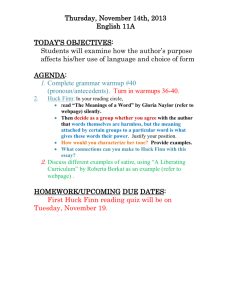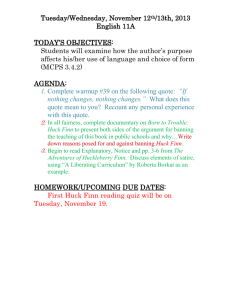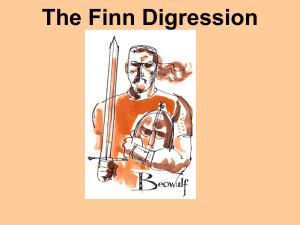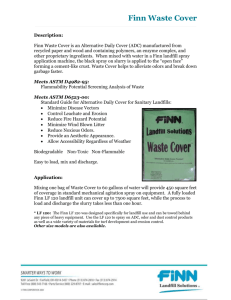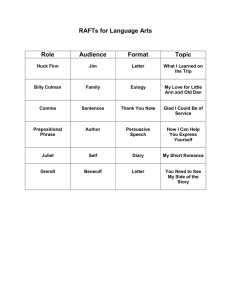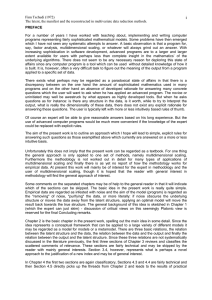Finn Tschudi, professor (em.) University of Oslo, NORWAYe-mail;
advertisement
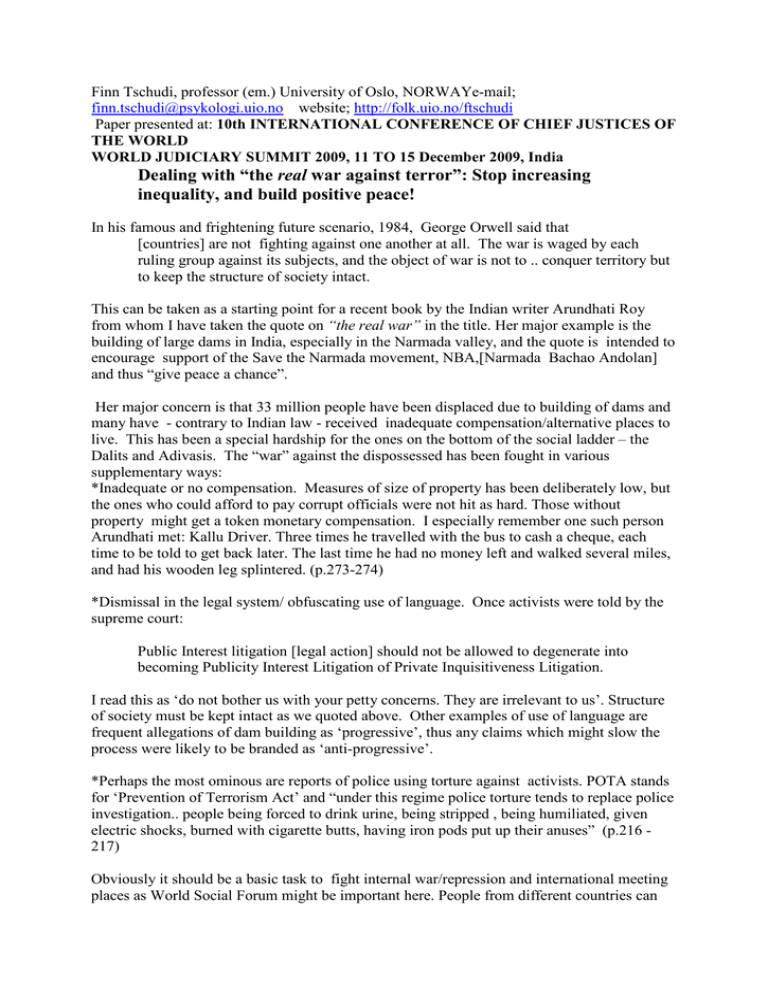
Finn Tschudi, professor (em.) University of Oslo, NORWAYe-mail; finn.tschudi@psykologi.uio.no website; http://folk.uio.no/ftschudi Paper presented at: 10th INTERNATIONAL CONFERENCE OF CHIEF JUSTICES OF THE WORLD WORLD JUDICIARY SUMMIT 2009, 11 TO 15 December 2009, India Dealing with “the real war against terror”: Stop increasing inequality, and build positive peace! In his famous and frightening future scenario, 1984, George Orwell said that [countries] are not fighting against one another at all. The war is waged by each ruling group against its subjects, and the object of war is not to .. conquer territory but to keep the structure of society intact. This can be taken as a starting point for a recent book by the Indian writer Arundhati Roy from whom I have taken the quote on “the real war” in the title. Her major example is the building of large dams in India, especially in the Narmada valley, and the quote is intended to encourage support of the Save the Narmada movement, NBA,[Narmada Bachao Andolan] and thus “give peace a chance”. Her major concern is that 33 million people have been displaced due to building of dams and many have - contrary to Indian law - received inadequate compensation/alternative places to live. This has been a special hardship for the ones on the bottom of the social ladder – the Dalits and Adivasis. The “war” against the dispossessed has been fought in various supplementary ways: *Inadequate or no compensation. Measures of size of property has been deliberately low, but the ones who could afford to pay corrupt officials were not hit as hard. Those without property might get a token monetary compensation. I especially remember one such person Arundhati met: Kallu Driver. Three times he travelled with the bus to cash a cheque, each time to be told to get back later. The last time he had no money left and walked several miles, and had his wooden leg splintered. (p.273-274) *Dismissal in the legal system/ obfuscating use of language. Once activists were told by the supreme court: Public Interest litigation [legal action] should not be allowed to degenerate into becoming Publicity Interest Litigation of Private Inquisitiveness Litigation. I read this as ‘do not bother us with your petty concerns. They are irrelevant to us’. Structure of society must be kept intact as we quoted above. Other examples of use of language are frequent allegations of dam building as ‘progressive’, thus any claims which might slow the process were likely to be branded as ‘anti-progressive’. *Perhaps the most ominous are reports of police using torture against activists. POTA stands for ‘Prevention of Terrorism Act’ and “under this regime police torture tends to replace police investigation.. people being forced to drink urine, being stripped , being humiliated, given electric shocks, burned with cigarette butts, having iron pods put up their anuses” (p.216 217) Obviously it should be a basic task to fight internal war/repression and international meeting places as World Social Forum might be important here. People from different countries can learn from each other, and spread news about efficient countermeasures. I hope Arundhati Roy can provide inspiration in building and maintaining activist organisation to fight against repressive forces, frequently big international organisations as Monsanto, Coca Cola etc. While fighting against internal wars/repression and strengthen civil rights is basic it should be supplemented with activities which - metaphorically speaking - are mainly concerned with creating light not only fighting against darkness. While the distinction may not also be crystal clear we choose in this area to champion Johan Galtung’s concepts negative and positive peace. Promoting negative peace inlcudes all efforts which may reduce/ promote absence of violence. All forms of non-violence, and also diplomatic negotiations – a multitrack approach - is called for (see Tschudi 2007 for a critique of too strong reliance on international law. This is certainly necessary but by no means sufficient.) Positive peace implies much more than absence of war and thus covers a large spectrum: Direct positive peace consists of verbal and physical kindness, good to the body, mind and spirit of Self and Others, addressed to all basic needs, survival, freedom and identity, and we must add; care for nature. Love is the epitome of positive peace; a union of bodies, mind and spirit. Structural positive peace substitutes freedom for repression and equity for exploitation. Furthermore legitimating of peace substitute for legitimating of violence in religion, science, art and schools. To further encourage positive peace Galtung states as a theorem: Positive peace is the best protection against violence It is not possible to list all relevant approaches to positive peace. I just sketch two quite different examples in the hope that this may inspire you to participate in ways to positive peace which are congenial to your interests and capabilities. The first example illustrates that even though a situation may look hopeless it may be possible – by simple means – to do what is good to body, mind and spirit. My English friend David Winter has repeatedly visited a mental hospital in Sierra Leone. Ravaged by civil war the place lacked almost all facilities and several of the inmates were chained to the walls. David asked them the simple question:’ what do you want’, and most of the patients gave the answer ‘music’. A cassette recorder was bought and some of the nurses provided cassettes. When the music started the patients started to dance even the ones chained to the wall! The music produced an atmosphere where it was no longer necessary to have anyone chained, and the door was thus opened for several other activities. Hopefully these programs serve to make staff more aware of the humanity of residents and invalidate any derogatory constructions of people with mental health problems. This reminds us of Mary Kaldor’s concept of building ‘islands of civility’ in war-torn societies When writing about this we used Braithwaite’s notion of triple loop learning. The first loop would be to make the music program self-sustaining, the second loop to inspire by word of mouth that similar programs be adopted at other locations, and the third loop would be to write about the program such that it inspires healthy development in other areas as well – as I try to do right here! My second example is to tell about some of my happiest experiences. A quarter of an hour away from the centre of Oslo there is the Ostensjo lake, a bird sanctuary where more than 200 species of birds have been seen. The lake and the surrounding area is today protected by law, and I belong to the group of ‘Friends of Ostensjo lake’ A recent activity I participated in was building bridge like structures where the foot path was very muddy. This had the dual purpose of making walking easier and also protecting the terrain from erosion. A special joy when participating in such activates is that people passing by are always happy when they see and understand what we are doing. Examples of other activities have been building small islands for the birds to nest, and setting up nets to prevent erosion of soil close to the lake. I like to think in terms of a religious metaphor: When we care for the landscape in a way which makes it pleasurable for all creatures God smiles and our fragile earth turns into a slightly better place to live. The group to which I belong rents a room for meetings on a farm close to the lake, and this makes me feel participating in ownership. This is, however, not the usual kind of ‘ownership’ which all too frequently is thought about in terms of excluding others from ‘my property’. In this case, however, my ‘ownership’ is what characterizes common goods as fresh water and clean air. Others are included, it adds to my joy to share with others. ‘I like to think of the variety of voluntary groups, whether the main concern is with protection of nature, or sports, or theatre, music and other arts, local history etc. etc. as the backbone of a viable civil society. Participation in such groups makes life richer, and thus contributes to positive peace. The third loop mentioned above may be seen as an example of building/ participating in a loose network. Your activity can inspire others, and what others do can provide inspiration for your work. I like to think of such networks as chains which unite us, and make us live in a larger world than just being caught in our everyday concerns, what Mohandas Gandhi talked about as a circle of cosmic interconnectedness. This also brings to mind the beautiful African notion of UBUNTU where my favourite translation is “I am because you are”. Put otherwise we create each other! Johan Galtung (1996). Peace by peaceful means. Sage: London. Mary Kaldor (2007). New and Old Wars. Second Edition. Stanford University Press. California. Arundhati Roy (2005). An ordinary person’s guide to empire. Penguin books: London. Finn Tschudi (2003). Finn ditt eget Ostensjo vann. Sothøna, nr. 26, 47-49. [Find your own Ostensjo lake. The Coot] Finn Tschudi (2007). Restorative justice and International law in the aftermath of mass violence: Talk softly, but carry a (big) stick. Paper presented at INTERNATIONAL CONFERENCE OF CHIEF JUSTICES OF THE WORLD ON ARTICLE 51(C) OF THE CONSTITUTION OF INDIA. LUCKNOW, INDIA. Available at, http://www.cmseducation.org/8article51/8thspeeches/finn.htm Finn Tschudi and David Winter (in press). The ABC model revisited
